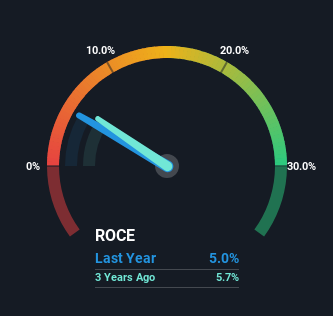We Like These Underlying Return On Capital Trends At Lanzhou LS Heavy Equipment (SHSE:603169)

If you're looking for a multi-bagger, there's a few things to keep an eye out for. Firstly, we'll want to see a proven return on capital employed (ROCE) that is increasing, and secondly, an expanding base of capital employed. Put simply, these types of businesses are compounding machines, meaning they are continually reinvesting their earnings at ever-higher rates of return. Speaking of which, we noticed some great changes in Lanzhou LS Heavy Equipment's (SHSE:603169) returns on capital, so let's have a look.
Return On Capital Employed (ROCE): What Is It?
For those that aren't sure what ROCE is, it measures the amount of pre-tax profits a company can generate from the capital employed in its business. The formula for this calculation on Lanzhou LS Heavy Equipment is:
Return on Capital Employed = Earnings Before Interest and Tax (EBIT) ÷ (Total Assets - Current Liabilities)
0.05 = CN¥270m ÷ (CN¥13b - CN¥7.6b) (Based on the trailing twelve months to September 2024).
So, Lanzhou LS Heavy Equipment has an ROCE of 5.0%. On its own that's a low return on capital but it's in line with the industry's average returns of 5.2%.
View our latest analysis for Lanzhou LS Heavy Equipment

Above you can see how the current ROCE for Lanzhou LS Heavy Equipment compares to its prior returns on capital, but there's only so much you can tell from the past. If you'd like to see what analysts are forecasting going forward, you should check out our free analyst report for Lanzhou LS Heavy Equipment .
What Can We Tell From Lanzhou LS Heavy Equipment's ROCE Trend?
Lanzhou LS Heavy Equipment has recently broken into profitability so their prior investments seem to be paying off. About five years ago the company was generating losses but things have turned around because it's now earning 5.0% on its capital. Not only that, but the company is utilizing 98% more capital than before, but that's to be expected from a company trying to break into profitability. This can indicate that there's plenty of opportunities to invest capital internally and at ever higher rates, both common traits of a multi-bagger.
In another part of our analysis, we noticed that the company's ratio of current liabilities to total assets decreased to 58%, which broadly means the business is relying less on its suppliers or short-term creditors to fund its operations. So this improvement in ROCE has come from the business' underlying economics, which is great to see. However, current liabilities are still at a pretty high level, so just be aware that this can bring with it some risks.
What We Can Learn From Lanzhou LS Heavy Equipment's ROCE
In summary, it's great to see that Lanzhou LS Heavy Equipment has managed to break into profitability and is continuing to reinvest in its business. Investors may not be impressed by the favorable underlying trends yet because over the last five years the stock has only returned 0.5% to shareholders. So exploring more about this stock could uncover a good opportunity, if the valuation and other metrics stack up.
On a final note, we found 3 warning signs for Lanzhou LS Heavy Equipment (1 can't be ignored) you should be aware of.
While Lanzhou LS Heavy Equipment may not currently earn the highest returns, we've compiled a list of companies that currently earn more than 25% return on equity. Check out this free list here.
If you're looking to trade Lanzhou LS Heavy Equipment, open an account with the lowest-cost platform trusted by professionals, Interactive Brokers.
With clients in over 200 countries and territories, and access to 160 markets, IBKR lets you trade stocks, options, futures, forex, bonds and funds from a single integrated account.
Enjoy no hidden fees, no account minimums, and FX conversion rates as low as 0.03%, far better than what most brokers offer.
Sponsored ContentNew: AI Stock Screener & Alerts
Our new AI Stock Screener scans the market every day to uncover opportunities.
• Dividend Powerhouses (3%+ Yield)
• Undervalued Small Caps with Insider Buying
• High growth Tech and AI Companies
Or build your own from over 50 metrics.
Have feedback on this article? Concerned about the content? Get in touch with us directly. Alternatively, email editorial-team (at) simplywallst.com.
This article by Simply Wall St is general in nature. We provide commentary based on historical data and analyst forecasts only using an unbiased methodology and our articles are not intended to be financial advice. It does not constitute a recommendation to buy or sell any stock, and does not take account of your objectives, or your financial situation. We aim to bring you long-term focused analysis driven by fundamental data. Note that our analysis may not factor in the latest price-sensitive company announcements or qualitative material. Simply Wall St has no position in any stocks mentioned.
About SHSE:603169
Lanzhou LS Heavy Equipment
Engages in the research and development, design, manufacture, engineering, and maintenance services of petrochemical and environmental protection equipment in China and internationally.
Reasonable growth potential with mediocre balance sheet.
Similar Companies
Market Insights
Community Narratives



